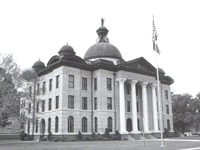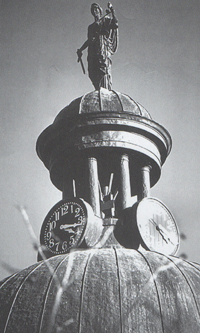
The cornerstone for the fifth courthouse was laid July 18, 1908 by the Masonic Order of Richmond.
A LITTLE PIECE OF HISTORY | By Joan Frances | Photos from Fort Bend County Texas: A Pictorial History.\-
When Stephen F. Austin and the Old Three Hundred families began settling in the Fort Bend area, residents established homesteads along the Brazos River, Big Creek, Oyster Creek, Buffalo Bayou and the San Bernard River. Transportation of mail, cotton and sugarcane, as well as local markers for boat traffic, kept the area growing and thriving. A post office, mercantile and bank emerged, making the area a focal point for residents to gather. As time progressed, plantations and farms were built and crops flourished. These plantation owners eventually became leaders, building cities and establishing law enforcement, and after a period of time, the first courthouse was built.
The City of Richmond was delegated the county seat of the Fort Bend government in 1837. In the mid 1800s, plans for a courthouse were drawn up by Robert E. Handy and William Lusk, the two founders of Richmond on Block 121. The plans were delayed, so a house at the end of Morton Street was purchased for $800 from the Lusk estate to serve as the first courthouse. This structure served a variety of important functions. Not only was it a meeting place for attorneys and clients, it also served as a place for residents to file lawsuits, and most importantly, it housed courtrooms and judicial chambers where decisions were written and released.
Finally, in 1849, a two-story brick structure was built by John H. Herndon, who was a lawyer and civil engineer. After the Civil War and during Reconstruction, the courthouse was relocated several times until a three-story building was purchased from C.H. Kendall for $7,500. The building was destroyed by a fire in 1887, forcing the leaders to explore other options.

Like most turn of the century courthouses, the Fort Bend County Courthouse is fashioned after the nation’s Capitol and state Capitols throughout the country with rotundas.
A new structure was built on the corner of Morton and Third Streets. This third building constructed on “Court House Square” featured a large clock and bell tower and was later used as a boarding house and recreation center. This location is now Richmond City Hall. In 1889, the famous Jaybird and Woodpecker feud ensued at the courthouse. The Jaybirds represented 90 percent of the white residents. The Republican government, nicknamed the Woodpeckers, was dominated by African-American office holders. The Jaybirds wanted complete control of the government. On August 16th, gunfire was exchanged at the courthouse, and lives were lost. In the end, the Woodpecker survivors retreated to the courthouse, and the Jaybirds took possession of the town. The Jaybird Monument is on display outside Richmond City Hall as a reminder of these arduous times.
The forth courthouse, built in 1908 at a cost of $75,000 and located at 401 Jackson Street, still stands today. It was designed by C.H. Page and Brothers, one of the pinnacle architects of the time. Charles Henry Page, Jr. was born in St. Louis, and his family moved to Austin, Texas in 1886 where his father worked in construction on the new Capitol. Page opened his practice in 1898 and was joined by his brother Louis. The building’s Texas Renaissance architectural style is made of brick and stone with a copper dome, turrets and a three-story rotunda. Beautiful mosaic tiles cover the floors, and green glazed tile covers the wainscoting. The hemispherical, copper clad dome is distinctive to other courthouses in Texas, as well as the Capitol building in Austin.
City leaders have continued to improve this illustrious building. Two additions were added in 1935 and 1957 that completed this courthouse. In 1980 and 1981, the structure was completely renovated to its original magnificence. In 2009, the county celebrated the courthouse’s 100th birthday. Today, the Fort Bend County Courthouse is listed in the National Register of Historic Places and is viewed as a tribute to Fort Bend successes.